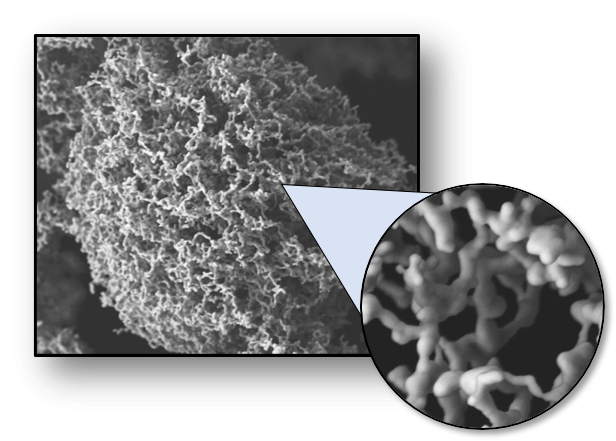Porous metals have combinations of properties that cannot be obtained with dense polymers, traditional metals and ceramics. Some of the advantages over these include being thermally and electrically conductive and maintaining their mechanical properties at higher temperatures.
At LLNL, nanoporous metals are needed for independent control of material/density in high-energy physics experiments, as an essential ingredient for ink used in additive manufacturing of printed batteries and sensors, and for basic science experiments investigating the fundamental mechanical and chemical properties of these materials.
The LLNL method is based on freeze‐casting of aerosolized and pressurized metal salt solutions and subsequent thermal processing. This method generates both porous particles with sizes down to one micron and macroscopic monoliths with nanometer scale ligaments/struts. The material's density can be controlled during the freeze‐dried stage. Compared to conventional approaches, this method offers high yield, purity, and uniformity.
The ease of customizing and tailoring materials for specific applications is one of the potential breakthroughs for this process. Potential uses in capacitors, batteries, catalyst and other areas could lead to increased efficiencies and longer lifetimes of components made by this process due to the added advantages it has over existing methods.
Open porosity is generally required for functions associated with the interior of the material and load bearing is not the primary goal. This is one reason this technology is potentially attractive as components for electrodes, catalyst, sensors, actuators, gas‐flow controlling devices, batteries, biomedical implants and filtration applications.
The freeze casting method for producing porous metal and metal compounds would have potential applications for Catalysts, Electrodes in energy storage devices (e.g., batteries, capacitors), Composites, Lightweight materials, Hydrogen Storage, X-ray Sources, Advanced Inks (e.g., 3D printing), Heat Sinks, Filtration, Desalinization, Antimicrobial/antibacterial Materials, Bio-Scaffolds, and Drug Delivery
This method is in use for applications at LLNL and a patent application has been filed for this freeze-casting method for producing porous metal and metal compounds.


